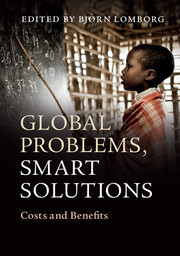Book contents
- Frontmatter
- Contents
- List of Figures
- List of Tables
- List of Contributors
- Acknowledgments
- Selected abbreviations and acronyms
- Introduction
- Part I The Solutions
- 1 Armed Conflicts
- 2 Ecosystems and Biodiversity
- 3 Chronic Disease
- 4 Climate Change
- 5 Education
- 6 Hunger and Malnutrition
- 7 Infectious Disease, Injury, and Reproductive Health
- 8 Natural Disasters
- 9 Population growth
- 10 Water and Sanitation
- 11 Corruption and Policy Reform
- 12 Trade Barriers and Subsidies
- Part II Ranking the Opportunities
- Conclusion: Making Your Own Prioritization
- Index
- References
8 - Natural Disasters
Published online by Cambridge University Press: 05 June 2014
- Frontmatter
- Contents
- List of Figures
- List of Tables
- List of Contributors
- Acknowledgments
- Selected abbreviations and acronyms
- Introduction
- Part I The Solutions
- 1 Armed Conflicts
- 2 Ecosystems and Biodiversity
- 3 Chronic Disease
- 4 Climate Change
- 5 Education
- 6 Hunger and Malnutrition
- 7 Infectious Disease, Injury, and Reproductive Health
- 8 Natural Disasters
- 9 Population growth
- 10 Water and Sanitation
- 11 Corruption and Policy Reform
- 12 Trade Barriers and Subsidies
- Part II Ranking the Opportunities
- Conclusion: Making Your Own Prioritization
- Index
- References
Summary
Introduction
Thirty years ago, large-scale natural disasters were considered to be low-probability, high-consequence events. Between 1970 and the mid 1980s, annual insured losses from natural disasters world-wide (including forest fires) were only in the $3–$4 billion range. Hurricane Hugo, which made landfall in Charleston, South Carolina, on September 22, 1989, was the first natural disaster in the United States to inflict more than $1 billion of insured losses. Times have changed.
Economic and insured losses from great natural catastrophes such as earthquakes, hurricanes, and floods have increased significantly in recent years. According to Munich Re (2013), economic losses from natural catastrophes increased from $528 billion (1981–1990), to $1,197 billion (1991–2000), to $1,213 billion (2001–2010). During the past ten years, the losses were principally due to hurricanes and resulting storm surge occurring in 2004, 2005, and 2008. Figure 8.1 depicts the evolution of the direct economic losses and the insured portion from great natural disasters over the period 1980–2012. Given the massive economic losses from the March 2011 earthquake and resulting tsunami in Japan, the year 2011 was the most costly year on record for disasters globally: $370 billion (Swiss Re, 2011).
- Type
- Chapter
- Information
- Global Problems, Smart SolutionsCosts and Benefits, pp. 439 - 509Publisher: Cambridge University PressPrint publication year: 2013
References
- 7
- Cited by



